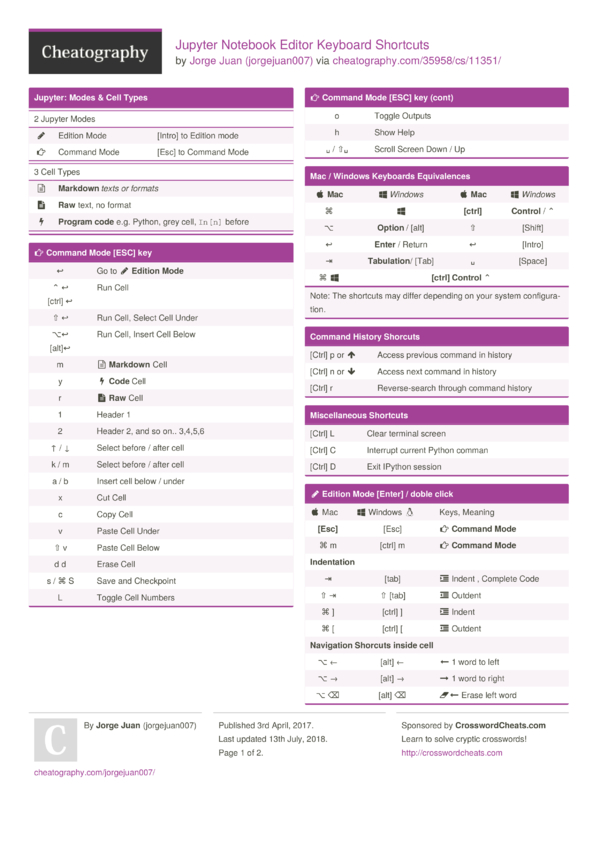

It also provides controls to stop the running server ( ) and launch the stopped server ( ). The Server log tab of this window shows the current state of the Jupyter server and the link to the notebook in a browser. The Server Log tab of the Jupyter tool window appears when you have any of the Jupyter server launched. You can preview the notebook in a browser.

Select this checkbox to allow executing JavaScript in your Jupyter notebook. Click the widget and select Configure Jupyter Server to setup another local or remote Jupyter server. I checked the Keyboard Shortcuts settings, but what I got were only the followings.
#Jupyter notebook shortcuts code
But it didnt, and let me out the code block - just like when Im using Tab in a webpage. (with Github Copilot) I thought it would provide tab or Copilot autocomplete when I press Tab key in a code block. The Jupyter Server widget that shows the currently used Jupyter server. I am working with ipynb file on Visual Studio Code.
#Jupyter notebook shortcuts install
To start working with Jupyter notebooks in IntelliJ IDEA: Create a new project, specify a virtual environment, and install the jupyter. Another option is using the JupyterLab, the next-generation notebook interface and you can customize it using JSON format in the User Preferences section. Quick start with the Jupyter notebook in IntelliJ IDEA. You can customize the keyboard shortcut in the Menu bar: Help - Edit Keyboard Shortcuts. You can select a cell type from this list and change the type for the selected cell. Shortcuts for basic operations with Jupyter notebooks. If there is no a cell below, IntelliJ IDEA will create it.Ĭlick this icon if you want to interrupt any cell execution.Ĭlick this icon to restart the currently running kernel. If you've selected an entire cell, the contents are pasted to a new cell below the selected one.Įxecutes this cell and selects a cell below. Inserts the contents of the clipboard into the selected location. Moves the entire cell if it's selected.Ĭopies the selected item or items to the clipboard. Moves the selected item or items from the current location to the clipboard. To enable them, open project Settings ( Control+Alt+S), go to Languages & Frameworks | Jupyter, and select the Show cell toolbar checkbox.Īdds a code cell below the selected cell. To enable them, open project Settings ( Control+Alt+S), go to Languages & Frameworks | Jupyter, and select the Show cell toolbar checkbox.Įach code cell has its configurable toolbar so that you can easily access the most popular commands and actions. The rest of the notebook specific actions are available in the Cell menu.Ĭode cell: a notebook cell that contains an executable codeĬell output: results of the code cell execution can be presented by a text output, table, or plot.Ĭell toolbar: a toolbar of the code cell with the most popular commands. Jupyter notebook toolbar: provides quick access to the most popular actions. Notebook editorĪ Jupyter notebook opened in the editor has its specific UI elements: A prompt should appear with more shortcuts for your needs. Mind the following user interface features when working with Jupyter notebooks in IntelliJ IDEA. For more shortcuts in Jupyter Notebook, press the ESC key to highlight a cell blue. To start working with Jupyter notebooks in IntelliJ IDEA:Ĭreate a new project, specify a virtual environment, and install the jupyter package.Įxecute any of the code cells to launch the Jupyter server. Quick start with the Jupyter notebook in IntelliJ IDEA Shortcuts for basic operations with Jupyter notebooks.Ībility to recognize. Notebook support in IntelliJ IDEA includes:Ībility to create line comments Control+/.Ībility to run cells and preview execution results. Click on the "JSON Settings Editor" button in the top right.With Jupyter Notebook integration available in IntelliJ IDEA through the Python plugin, you can easily edit, execute, and debug notebook source code and examine execution outputs including stream data, images, and other media.In the Jupyter window, go to "Settings" -> "Advanced Settings Editor".If you're working in JupyterLab, you can edit the JSON settings directly to add a simple keyboard shortcut to "run all cells".


 0 kommentar(er)
0 kommentar(er)
